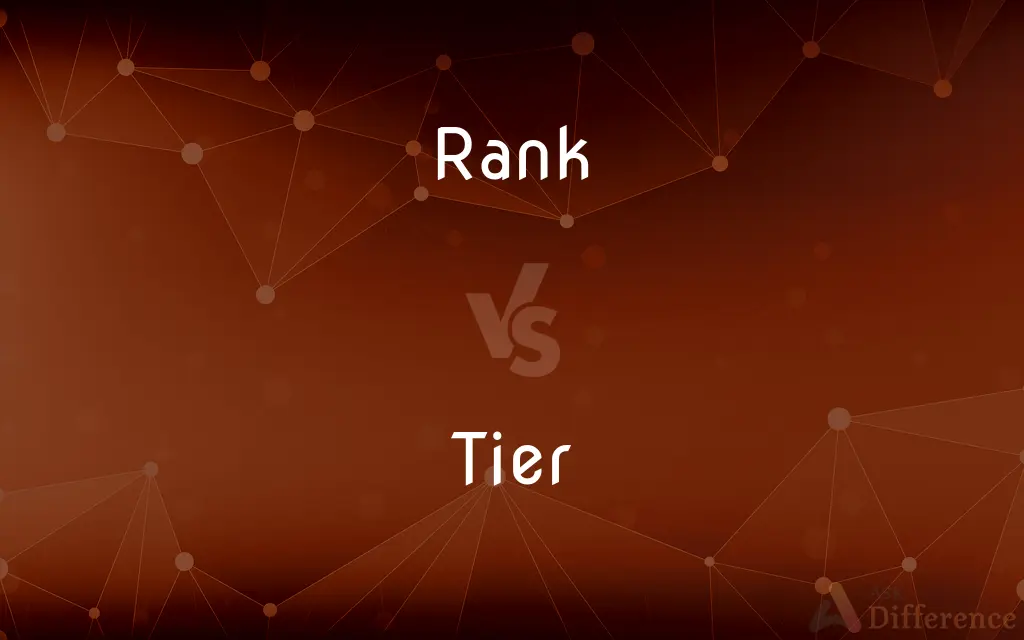Rank vs. Tier — What's the Difference?
By Urooj Arif & Fiza Rafique — Updated on April 2, 2024
Rank refers to a position within a hierarchical or sequential order, often based on performance or status, while tier represents a level within a classification system, grouping entities with similar characteristics or qualities.

Difference Between Rank and Tier
Table of Contents
ADVERTISEMENT
Key Differences
Rank is typically used to denote a specific position or status within a hierarchical structure, suggesting a linear or vertical arrangement where positions are determined by criteria such as performance, seniority, or achievement. This implies a direct comparison between entities, where each rank is a unique position. Whereas tier refers to a broader categorization or grouping within a system, where each tier consists of entities that share certain characteristics, qualities, or have met specific criteria, without implying a linear or direct comparison between individual entities within the same tier.
Rank often suggests a finer granularity of comparison, where entities are sorted into a precise order based on quantifiable measures. For example, in a military or organizational context, rank determines one's position and responsibilities relative to others. On the other hand, tier is used in contexts where it's necessary to classify entities into broader categories that reflect a range of positions or qualities, such as different levels of membership, services, or products, which are distinct yet not directly comparable in a linear fashion.
Rank can change frequently based on performance or outcomes, as seen in competitive environments like sports or academic standings, where individuals or teams move up or down in rank based on their recent performances. While tier systems are often more stable, designed to segment or organize entities into levels that reflect their overall status, quality, or achievement over time, adjustments within tiered systems may occur but are generally less frequent and based on significant changes in the criteria defining each tier.
Rank is inherently competitive and individualistic, emphasizing the relative position of each entity within a group or system. It is a dynamic measure that can fluctuate regularly. Whereas tier emphasizes classification and grouping, reflecting a collective status or categorization that does not necessarily change with minor variations in performance or characteristics of the entities it includes.
Rank and tier both serve to organize and clarify the structure within systems, but they do so in different ways. Rank does this through a detailed hierarchy that allows for precise distinctions in position or status. While tier does this by grouping entities into categories that simplify understanding of a system's structure, making it easier to communicate about broad levels of achievement, service, quality, or functionality without needing to specify an exact rank within those categories.
ADVERTISEMENT
Comparison Chart
Definition
A position within a hierarchical order based on criteria.
A level within a classification system grouping similar entities.
Context
Used in hierarchical or competitive systems.
Used in systems that classify entities into broad categories.
Comparison
Linear and direct, with precise distinctions.
Broad and categorical, without direct comparisons within tiers.
Stability
Can change frequently based on performance.
Generally more stable, changes reflect significant shifts.
Emphasis
On individual position or status.
On grouping or classification of entities.
Compare with Definitions
Rank
A position in a hierarchical system.
She achieved the top rank in her class.
Tier
A level within a categorization system.
The premium tier offers more benefits.
Rank
Level of importance or prestige.
This issue is of high rank and requires immediate attention.
Tier
Grouping of entities with similar characteristics.
Cities are classified into tiers based on their population.
Rank
A title or designation in military or formal organizations.
He was promoted to the rank of captain.
Tier
A layer or echelon in a structured system.
The organization introduced a new tier for junior members.
Rank
Relative standing in a competitive environment.
The player's global rank rose significantly this season.
Tier
Classification level reflecting quality or status.
She subscribed to a higher service tier for better features.
Rank
Order or position based on performance or criteria.
The team's rank improved after the last game.
Tier
Broad category within a hierarchy.
The top tier of the league dominates in terms of performance.
Rank
A relative position in a society.
Tier
One of a series of rows placed one above another
A stadium with four tiers of seats.
Rank
An official position or grade
The rank of sergeant.
Tier
A rank or class.
Rank
A relative position or degree of value in a graded group.
Tier
To arrange (something) into or rise in tiers
Tier a wedding cake.
Balconies that tier upward.
Rank
High or eminent station or position
Persons of rank.
Tier
One who ties (knots, etc).
Rank
A row, line, series, or range.
Tier
Something that ties.
Rank
A line of soldiers, vehicles, or equipment standing side by side in close order.
Tier
(archaic) A child's apron.
Rank
Ranks The armed forces.
Tier
A layer or rank, especially of seats or a wedding cake.
Stoke City were playing in the second tier of English football before being promoted to the Premier League.
Rank
Ranks Personnel, especially enlisted military personnel.
Tier
(transitive) To arrange in layers.
Rank
Ranks A body of people classed together; numbers
Joined the ranks of the unemployed.
Tier
(transitive) To cascade in an overlapping sequence.
Rank
(Games) Any of the rows of squares running crosswise to the files on a playing board in chess or checkers.
Tier
To move (data) from one storage medium to another as an optimization, based on how frequently it is accessed.
Rank
To place in a row or rows.
Tier
One who, or that which, ties.
Rank
To give a particular order or position to; classify.
Tier
A chold's apron covering the upper part of the body, and tied with tape or cord; a pinafore.
Rank
To outrank or take precedence over.
Tier
A row or rank, especially one of two or more rows placed one above, or higher than, another; as, a tier of seats in a theater.
Rank
To hold a particular rank
Ranked first in the class.
Tier
A relative position or degree of value in a graded group;
Lumber of the highest grade
Rank
To form or stand in a row or rows.
Tier
Any one of two or more competitors who tie one another
Rank
To complain.
Tier
A worker who ties something
Rank
To engage in carping criticism. Often used with on
Stop ranking on me all the time.
Tier
Something that is used for tying;
The sail is fastened to the yard with tiers
Rank
Growing profusely or with excessive vigor
Rank vegetation.
Tier
One of two or more layers one atop another;
Tier upon tier of huge casks
A three-tier wedding cake
Rank
Yielding a profuse, often excessive crop; highly fertile
Rank earth.
Rank
Strong and offensive in odor or flavor
Rank gym clothes.
Rank
Absolute; complete
A rank amateur.
Rank treachery.
Rank
Strong of its kind or in character; unmitigated; virulent; thorough; utter (used of negative things).
Rank treason
Rank nonsense
Rank
Strong in growth; growing with vigour or rapidity, hence, coarse or gross.
Rank grass
Rank weeds
Rank
Suffering from overgrowth or hypertrophy; plethoric.
Rank
Causing strong growth; producing luxuriantly; rich and fertile.
Rank land
Rank
Strong to the senses; offensive; noisome.
Rank
Having a very strong and bad taste or odor.
Your gym clothes are rank, bro – when'd you last wash 'em?
Rank
Complete, used as an intensifier (usually negative, referring to incompetence).
I am a rank amateur as a wordsmith.
Rank
(informal) Gross, disgusting.
Rank
(obsolete) Strong; powerful; capable of acting or being used with great effect; energetic; vigorous; headstrong.
Rank
(obsolete) lustful; lascivious
Rank
(obsolete) Quickly, eagerly, impetuously.
Rank
A row of people or things organized in a grid pattern, often soldiers.
The front rank kneeled to reload while the second rank fired over their heads.
Rank
(chess) One of the eight horizontal lines of squares on a chessboard (i.e., those identified by a number).
Rank
(music) In a pipe organ, a set of pipes of a certain quality for which each pipe corresponds to one key or pedal.
Rank
One's position in a list sorted by a shared property such as physical location, population, or quality.
Based on your test scores, you have a rank of 23.
The fancy hotel was of the first rank.
Rank
The level of one's position in a class-based society.
Rank
(typically in the plural) A category of people, such as those who share an occupation or belong to an organisation.
A membership drawn from the ranks of wealthy European businessmen
Rank
A hierarchical level in an organization such as the military.
Private First Class (PFC) is the second-lowest rank in the Marines.
He rose up through the ranks of the company, from mailroom clerk to CEO.
Rank
(taxonomy) A level in a scientific taxonomy system.
Phylum is the taxonomic rank below kingdom and above class.
Rank
(mathematics) The dimensionality of an array (computing) or tensor.
Rank
(linear algebra) The maximal number of linearly independent columns (or rows) of a matrix.
Rank
(algebra) The maximum quantity of D-linearly independent elements of a module (over an integral domain D).
Rank
(mathematics) The size of any basis of a given matroid.
Rank
To place abreast, or in a line.
Rank
To have a ranking.
Their defense ranked third in the league.
Rank
To assign a suitable place in a class or order; to classify.
Rank
(US) To take rank of; to outrank.
Rank
Luxuriant in growth; of vigorous growth; exuberant; grown to immoderate height; as, rank grass; rank weeds.
And, behold, seven ears of corn came up upon one stalk, rank and good.
Rank
Raised to a high degree; violent; extreme; gross; utter; as, rank heresy.
Rank
Causing vigorous growth; producing luxuriantly; very rich and fertile; as, rank land.
Rank
Strong-scented; rancid; musty; as, oil of a rank smell; rank-smelling rue.
Rank
Strong to the taste.
Rank
Inflamed with venereal appetite.
Rank
Rankly; stoutly; violently.
That rides so rank and bends his lance so fell.
Rank
A row or line; a range; an order; a tier; as, a rank of osiers.
Many a mountain nighRising in lofty ranks, and loftier still.
Rank
A line of soldiers ranged side by side; - opposed to file. See 1st File, 1 (a).
Fierce, fiery warriors fought upon the clouds,In ranks and squadrons and right form of war.
Rank
Grade of official standing, as in the army, navy, or nobility; as, the rank of general; the rank of admiral.
Rank
An aggregate of individuals classed together; a permanent social class; an order; a division; as, ranks and orders of men; the highest and the lowest ranks of men, or of other intelligent beings.
Rank
Degree of dignity, eminence, or excellence; position in civil or social life; station; degree; grade; as, a writer of the first rank; a lawyer of high rank.
These all are virtues of a meaner rank.
Rank
Elevated grade or standing; high degree; high social position; distinction; eminence; as, a man of rank.
Rank
To place abreast, or in a line.
Rank
To range in a particular class, order, or division; to class; also, to dispose methodically; to place in suitable classes or order; to classify.
Ranking all things under general and special heads.
Poets were ranked in the class of philosophers.
Heresy is ranked with idolatry and witchcraft.
Rank
To take rank of; to outrank.
Rank
To be ranged; to be set or disposed, as in a particular degree, class, order, or division.
Let that one article rank with the rest.
Rank
To have a certain grade or degree of elevation in the orders of civil or military life; to have a certain degree of esteem or consideration; as, he ranks with the first class of poets; he ranks high in public estimation.
Rank
A row or line of people (especially soldiers or police) standing abreast of one another;
The entrance was guarded by ranks of policemen
Rank
Relative status;
His salary was determined by his rank and seniority
Rank
The ordinary members of an organization (such as the enlisted soldiers of an army);
The strike was supported by the union rank and file
He rose from the ranks to become a colonel
Rank
Position in a social hierarchy;
The British are more aware of social status than Americans are
Rank
The body of members of an organization or group;
They polled their membership
They found dissension in their own ranks
He joined the ranks of the unemployed
Rank
Take or have a position relative to others;
This painting ranks among the best in the Western World
Rank
Assign a rank or rating to;
How would you rank these students?
The restaurant is rated highly in the food guide
Rank
Take precedence or surpass others in rank
Rank
Very fertile; producing profuse growth;
Rank earth
Rank
Very offensive in smell or taste;
A rank cigar
Rank
Conspicuously and outrageously bad or reprehensible;
A crying shame
An egregious lie
Flagrant violation of human rights
A glaring error
Gross ineptitude
Gross injustice
Rank treachery
Rank
Complete and without restriction or qualification; sometimes used informally as intensifiers;
Absolute freedom
An absolute dimwit
A downright lie
Out-and-out mayhem
An out-and-out lie
A rank outsider
Many right-down vices
Got the job through sheer persistence
Sheer stupidity
Rank
Growing profusely;
Rank jungle vegetation
Common Curiosities
How do ranks and tiers differ in competitive gaming?
In competitive gaming, rank indicates a player's precise standing based on their performance, while tier groups players by skill level or achievements without specifying exact positions.
How do ranks affect decision-making in organizations?
Ranks affect decision-making by clarifying authority, responsibility, and the flow of communication within organizations.
What determines one's rank?
One's rank is determined by performance, achievement, seniority, or specific criteria within a hierarchical system.
How do tiers help in product marketing?
Tiers help in product marketing by allowing companies to segment offerings into distinct levels, making it easier for consumers to choose based on their needs or budget.
Can entities move between tiers?
Yes, entities can move between tiers, but such changes usually reflect significant shifts in classification criteria.
Is tier a more stable classification than rank?
Yes, tier is generally more stable as it groups entities into broad categories, whereas rank can change frequently with performance.
Can an organization use both ranks and tiers?
Yes, an organization can use both ranks and tiers for different purposes, such as defining hierarchical positions and grouping services or members.
How do ranks influence team dynamics in sports?
Ranks influence team dynamics by motivating individuals to improve performance and achieve a higher standing, fostering competition and collaboration.
How does the concept of rank differ in academic vs. corporate environments?
In academic environments, rank often refers to standings based on grades or research impact, while in corporate environments, it denotes hierarchical positions and authority.
Why might a business choose to implement a tiered service model?
A business might implement a tiered service model to cater to diverse customer needs, preferences, and willingness to pay, enhancing satisfaction and revenue.
What role do ranks play in military organizations?
In military organizations, ranks define the hierarchy, roles, responsibilities, and authority of personnel.
What is the significance of tier systems in healthcare?
In healthcare, tier systems classify drugs, treatments, or providers into categories based on cost, efficacy, or coverage, guiding patients' choices.
Can tiers reflect quality differences in products or services?
Yes, tiers often reflect quality differences, with higher tiers indicating superior features, services, or privileges.
How do educational institutions use ranks?
Educational institutions use ranks to denote students' standings based on grades or achievements within their class or program.
Can the concept of tiers apply to social stratification?
Yes, the concept of tiers can apply to social stratification, where society is divided into groups based on socioeconomic status, although this usage is more analytical than formal.
Share Your Discovery

Previous Comparison
Alegar vs. Vinegar
Next Comparison
Core vs. HeartAuthor Spotlight
Written by
Urooj ArifUrooj is a skilled content writer at Ask Difference, known for her exceptional ability to simplify complex topics into engaging and informative content. With a passion for research and a flair for clear, concise writing, she consistently delivers articles that resonate with our diverse audience.
Co-written by
Fiza RafiqueFiza Rafique is a skilled content writer at AskDifference.com, where she meticulously refines and enhances written pieces. Drawing from her vast editorial expertise, Fiza ensures clarity, accuracy, and precision in every article. Passionate about language, she continually seeks to elevate the quality of content for readers worldwide.














































